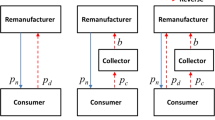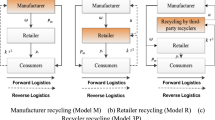Abstract
We investigate how government subsidies affect pricing and service-quality strategies under different online-recycling channel structures. We consider two cases: the monopoly case, where the manufacturer recycles by itself, and the coopetition case, where a platform and the manufacturer compete for used products while the platform provides services to the manufacturer. We find the optimal price and service-quality strategies in these two cases with or without government subsidy. We also examine the recycling outcomes in terms of total recycling quantities and the parties’ profits. We find that with government subsidy, in the monopoly case, the manufacturer is motivated to increase both acquisition price and service quality and thus achieves higher recycling quantities and profit. In the case of coopetition, the manufacturer enjoys similar benefits from subsidy, but the platform suffers. The manufacturer gains competitive advantage from subsidy by offering a higher acquisition price, which forces the platform to increase acquisition price as well. To compensate for this increased cost, the platform must lower service quality, which leads to lower recycling quantities and profits. Only when the subsidy is high enough can the platform benefit. We also show that a subsidy can increase the total recycling quantity of the system only when consumers are fairly insensitive to service quality. Our study contributes to the understanding of how subsidy policy interacts with different online channel structures.





Similar content being viewed by others
References
Adner R, Chen J, Zhu F (2020) Frenemies in platform markets: heterogeneous profit foci as drivers of compatibility decisions. Manag Sci 66(6):2432–2451
Atasu A, Toktay LB, Van Wassenhove LN (2013) How collection cost structure drives a manufacturer’s reverse channel choice. Prod Oper Manag 22(5):1089–1102
Choi TM, Li Y, Xu L (2013) Channel leadership, performance and coordination in closed loop supply chains. Int J Prod Econ 146(1):371–380
Chuang CH, Wang X, Zhao Y (2014) Closed-loop supply chain models for a high-tech product under alternative reverse channel and collection cost structures. Int J Prod Econ 156:108–123
Dai D, Si F, Wang J (2017) Stability and complexity analysis of a dual-channel closed-loop supply chain with delayed decision under government intervention. Entropy 19(11):577
Gao J, Han H, Hou L, Wang H (2016) Pricing and effort decisions in a closed-loop supply chain under different channel power structures. J Clean Prod 112(3):2043–2057
Gong Y, Da Q, Zhan J (2016) Research on closed-loop supply chain based on processing funds and dismantling subsidies. Chinese Journal of Management Science 24(6):97–105
Giri B, Chakraborty A, Maiti T (2017) Pricing and return product collection decisions in a closed-loop supply chain with dual-channel in both forward and reverse logistics. J Manuf Syst 42:104–123
He P, He Y, Xu H (2019) Channel structure and pricing in a dual-channel closed-loop supply chain with government subsidy. Int J Prod Econ 213:108–123
Hong X, Wang Z, Wang D, Zhang H (2013) Decision models of closed-loop supply chain with remanufacturing under hybrid dual-channel collection. Int J Adv Manuf Technol 68(5–8):1851–1865
Huang M, Song M, Lee LH, Ching WK (2013) Analysis for strategy of closed-loop supply chain with dual recycling channel. Int J Prod Econ 144(2):510–520
Li C, Feng L (2016) Strategic analysis of dual-recycling channel design for WEEE considering customer preferences. J Syst Eng 31(4):494–503
Li H, Wang C, Xu L, Ou W (2017) Pricing, carbon emission reduction, collection decision, and coordination in a low-carbon closed-loop supply chain. J Renew Sustain Energy 9:065907
Liu L, Wang Z, Xu L, Hong X, Govindan K (2017) Collection effort and reverse channel choices in a closed-loop supply chain. J Clean Prod 144:492–500
Ma W, Zhao Z, Ke H (2013) Dual-channel closed-loop supply chain with government consumption-subsidy. Eur J Oper Res 226(2):221–227
Mitra S, Webster S (2008) Competition in remanufacturing and the effects of government subsidies. Int J Prod Econ 111(2):287–298
Panda S, Modak NM, Cárdenas-Barrón LE (2017) Coordinating a socially responsible closed-loop supply chain with product recycling. Int J Prod Econ 188:11–21
Savaskan RC, Bhattacharya S, Van Wassenhove LN (2004) Closed-loop supply chain models with product remanufacturing. Manag Sci 50(2):239–252
Song W, Chen J, Li W (2020) Spillover effect of consumer awareness on third parties' selling strategies and retailers' platforms openness. Inf Syst Res 28(3):1–38
Wan N, Hong D (2019) The impacts of subsidy policies and transfer pricing policies on the closed-loop supply chain with dual collection channels. J Clean Prod 224:881–891
Wang K, Zhao Y, Cheng Y, Choi TM (2014) Cooperation or competition? Channel choice for a remanufacturing fashion supply chain with government subsidy. Sustainability 6(10):7292–7310
Wang T, Yan B, Li H (2018) Decision and coordination of online channels with competition of substitute product’s price and service. J Syst Eng 33(4):536–550
Wang W, Zhang Y, Zhang K, Bai T, Shang J (2015) Reward–penalty mechanism for closed-loop supply chains under responsibility-sharing and different power structures. Int J Prod Econ 170:178–190
Wang Y, Li J (2018) Research on dominant models of E-CLSC based on network sale and recycle considering fairness concern. Chin J Manag Sci 26(1):139–151
Wang Y, Xin B, Wang Z, Li B (2019) Managing supplier–manufacturer closed-loop supply chain considering product design and take-back legislation. Int J Environ Res Public Health 16(4):623
Wu CH (2012) Price and service competition between new and remanufactured products in a two-echelon supply chain. Int J Prod Econ 140(1):496–507
Xie J, Liang L, Yang G, Kong F, Chen Y (2018) Contract coordination and optimization of revenue-sharing and cost-sharing in complementary closed-loop supply chain. Chin J Manag Sci 26(8):94–105
Zhang Z, Wang Z, Liu L (2015) Retail services and pricing decisions in a closed-loop supply chain with remanufacturing. Sustainability 7(3):2373–2396
Zhu X, Wu B, Wang Z (2017) Closed-loop supply chain pricing strategy and coordination mechanism under the difference of dual-channel recycling cost. Chin J Manag Sci 25(12):188–196
Acknowledgements
This research was supported by National Natural Science Foundation of China (#71671054). It was also supported by the Research on Collaborative Innovations of Duel Circulation System of High-quality Agricultural Products Supply Chain innitiative of the government Advanced Talents Program. The authors would like to thank the editors and anonymous reviewers for their great help and support.
Author information
Authors and Affiliations
Corresponding author
Additional information
Publisher's Note
Springer Nature remains neutral with regard to jurisdictional claims in published maps and institutional affiliations.
Appendix: Proofs
Appendix: Proofs
Proof of Lemma 1
The Hessian matrix of \(\prod_{m}^{M}\) with respect to \(p\), \(P_{m}\), and \(s\) is
\(H_{1}\) is a negative-definite matrix. Therefore, a unique optimal solution exists. By the first-order conditions of \(\prod_{m}^{M}\) with respect to \(p\), \(P_{m}\), and \(s\), we have
Based on the first equation, we can derive the optimal price \(p_{{}}^{M*} = (c + \varphi )/2\). Based on the second and third equations, we can derive optimal acquisition price \(P_{m}^{M*}\) and the manufacturer's optimal service level \(s^{M*}\) as in Lemma 1. Substituting \(p_{{}}^{M*}\), \(P_{m}^{M*}\), \(s^{M*}\) into \(Q_{m}\) and \(\prod_{m}\) in Eqs. (1) and (4), we can derive the manufacturer’s (which is also the system’s) optimal recycling quantity \(Q^{M*}\) and the manufacturer’s optimal profit \(\prod_{m}^{M*}\) as in Lemma 1.
Proof of Proposition 1
We use superscript N to denote the equilibrium outcome for the case with no government subsidy. By Lemma 1, we can obtain \(P_{m}^{M*} - P_{m}^{NM*} = \frac{{g(1 - \beta^{2} )}}{{2 - \beta^{2} }} > 0\), \(s^{M*} - s^{NM*} = \frac{g\beta }{{2 - \beta^{2} }} > 0\), and \(Q_{{}}^{M*} - Q_{{}}^{NM*} = \frac{g}{{2 - \beta^{2} }} > 0\).
Proof of Lemma 2
We first derive the Hessian matrix of \(\prod_{t}^{MP}\) with respect to \(P_{t}\) and \(s\):
\(H_{2}\) is a negative-definite matrix. Therefore, a unique optimal solution exists. By the first-order condition of maximizing the platform’s profit, we can derive her optimal price and service level, given the manufacturer’s price:
Substituting \(P_{t}^{*} (P_{m} )\) and \(s^{*} (P_{m} )\) into \(\prod_{m}^{MP}\), we get the Hessian matrix of \(\prod_{m}^{MR}\):
We notice that \(\prod_{m}^{MP}\) is jointly concave on \(p\) and \(P_{m}^{MP}\) when the condition \(2 - \alpha^{2} - \beta^{2} - \alpha \beta^{2} > 0\) is satisfied.
Under this condition, based on the first-order conditions of \(\prod_{m}^{MP}\) with respect to \(p\) and \(P_{m}^{MP}\), we can derive the equilibrium selling price \(p^{MP*}\) and the equilibrium acquisition price \(P_{m}^{MP*}\) as in Lemma 2. By substituting \(p^{MP*}\) and \(P_{m}^{MP*}\) into \(P_{t}^{*} (P_{m} )\) and \(s^{*} (P_{m} )\), we can derive the platform’s equilibrium acquisition price, \(P_{t}^{MP*}\), and service level, \(s^{MP*}\), as in Lemma 2. By substituting \(P_{m}^{MP*}\), \(P_{t}^{MP*}\), and \(s^{MP*}\) into Eqs. (2) and (3), we can derive \(Q_{m}^{MP*}\) and \(Q_{t}^{MP*}\) as in Lemma 2. Similarly, by substituting the equilibrium prices and service levels into Eqs. (5) and (6), we can derive \(\Pi_{m}^{MP*}\) and \(\Pi_{t}^{MP*}\) as in Lemma 2.
Proof of Proposition 2
We use superscript N to denote the equilibrium outcome for the case with no government subsidy. By Lemma 2, we have \(P_{m}^{MP*} - P_{m}^{NMP*} = g/2 > 0\), and
In addition, we have
and
Proof of Proposition 3
We use superscript N to denote the equilibrium outcome for the case without government subsidy. By Proposition 1, a government subsidy increases recycling quantity in Model M.
In Model MP, we have
Therefore, \(Q^{MP*} - Q^{NMP*} > 0\) if and only if \((2 - \alpha^{2} - \beta^{2} - \alpha \beta^{2} - \alpha ) > 0\), which is equivalent to the condition prescribed in the proposition.
Proof of Proposition 4
(a) In Model M, by Lemma 1, we have
In Model MP, by Lemma 2, we have.
\(\prod_{m}^{MP*} - \prod_{m}^{NMP*} = \frac{{g[K_{1} (2\delta + g) + 2\lambda K_{4} (1 + \alpha ) - 2vK_{3} ]}}{{4(2 - \beta^{2} )}} > 0\).
The inequality is because \(2[\delta K_{1} + \lambda K_{4} (1 + \alpha ) - vK_{3} ] > 0\) based on \(Q_{m}^{NMP*} > 0\).
(b) By Lemma 2, we have.
\(\prod_{t}^{MP*} - \prod_{t}^{NMP*} = \frac{{\alpha^{2} gK_{1} (2\delta + g) + 2g\lambda (2K_{1}^{2} - \alpha^{2} K_{2} ) - 2\alpha gv(K_{1} + K_{5} )}}{{8K_{1} (2 - \beta^{2} )}}\).
Because the denominator is positive, the above is positive if and only if the numerator is positive, which is equivalent to the condition prescribed in the proposition.
Proof of Proposition 5
(a) By Lemma 1, we have
By Lemma 2, we have \(\partial P_{m}^{MP*} /\partial g = 1/2 > 0\), and
In addition, we have
(b) By Lemma 1, we have
By Lemma 2, we have
(c) By Lemma 1, we have
By Eq. (10), we have
Therefore, \(\partial Q_{{}}^{MP*} /\partial g > 0\) if and only if \((2 - \alpha^{2} - \beta^{2} - \alpha \beta^{2} - \alpha ) > 0\), which is equivalent to the condition prescribed in the proposition. Moreover, we have
Proof of Proposition 6
(a) By Lemma 1, we have
(b) By Lemma 2, we have
Rights and permissions
About this article
Cite this article
Bai, S., Ge, L. & Zhang, X. Platform or direct channel: government-subsidized recycling strategies for WEEE. Inf Syst E-Bus Manage 20, 347–369 (2022). https://doi.org/10.1007/s10257-021-00517-4
Received:
Revised:
Accepted:
Published:
Issue Date:
DOI: https://doi.org/10.1007/s10257-021-00517-4




